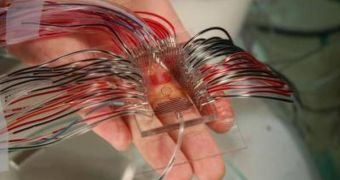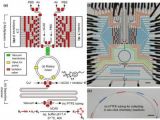Scientists at the University of California in Los Angeles (UCLA) have recently developed a new microchip that has the ability to completely revolutionize the field of chemistry research. Flask, beaks, hot plates and Berzelius glasses could soon become a thing of the past, and tabletop experiments could be confined to a space the size of a thumbnail. In the future, the new stamp-size, PC-controlled microchip could be used for identifying drugs to treat conditions such as cancer faster too.
Thousands of chemical reactions can be run on the single microfluidic device at the same time, a trait that could lead to much lower lab waiting times, before results pop up. Instead of using traditional chemical lab instruments, in the future, scientists could simply plug a microchip inside the computer, and run several research lines' worth of reaction at the same time. Details of the accomplishment will appear in the August 21st issue of the journal Lab on a Chip, but are already available online.
“The precious enzyme molecules required for a single in situ click reaction in a traditional lab now can be split into hundreds of duplicates for performing hundreds of reactions in parallel, thus revolutionizing the laboratory process, reducing reagent consumption and accelerating the process for identifying potential drug candidates,” UCLA Crump Institute for Molecular Imaging expert Hsian-Rong Tseng, the author of the new paper, explains the new device. He also holds an appointment as an associate professor of molecular and medical pharmacology at the university's David Geffen School of Medicine, and is a California NanoSystems Institute member.
“The system allows researchers to not only test compounds quicker but uses only tiny amounts of materials, which greatly reduces lab time and costs,” Pasarow Mass Spectrometry Lab Director Kym F. Faull, also a professor of psychiatry and biobehavioral sciences at the Geffen School of Medicine, adds. The expert participated in the research as well, helping the science team tackle serious problems such as reducing the amount of chemicals needed for reactions on the microfluidic device, enhancing the overall sensitivity of the machine, and speeding up the reaction-analysis process.

 14 DAY TRIAL //
14 DAY TRIAL // 
